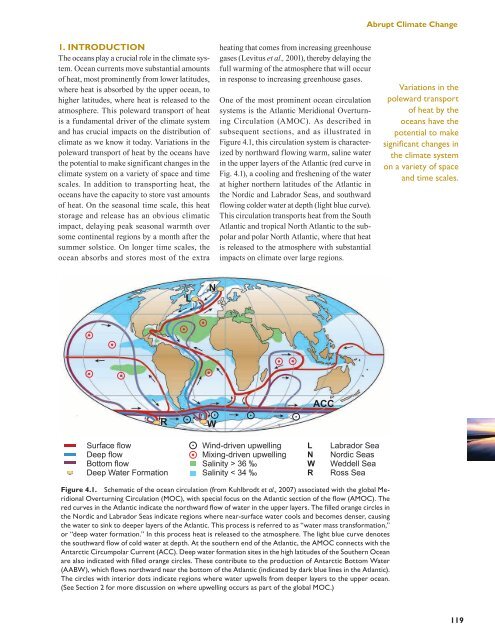Book 2.indb - US Climate Change Science Program
Book 2.indb - US Climate Change Science Program
Book 2.indb - US Climate Change Science Program
- No tags were found...
You also want an ePaper? Increase the reach of your titles
YUMPU automatically turns print PDFs into web optimized ePapers that Google loves.
Abrupt <strong>Climate</strong> <strong>Change</strong>1. IntroductionThe oceans play a crucial role in the climate system.Ocean currents move substantial amountsof heat, most prominently from lower latitudes,where heat is absorbed by the upper ocean, tohigher latitudes, where heat is released to theatmosphere. This poleward transport of heatis a fundamental driver of the climate systemand has crucial impacts on the distribution ofclimate as we know it today. Variations in thepoleward transport of heat by the oceans havethe potential to make significant changes in theclimate system on a variety of space and timescales. In addition to transporting heat, theoceans have the capacity to store vast amountsof heat. On the seasonal time scale, this heatstorage and release has an obvious climaticimpact, delaying peak seasonal warmth oversome continental regions by a month after thesummer solstice. On longer time scales, theocean absorbs and stores most of the extraheating that comes from increasing greenhousegases (Levitus et al., 2001), thereby delaying thefull warming of the atmosphere that will occurin response to increasing greenhouse gases.One of the most prominent ocean circulationsystems is the Atlantic Meridional OverturningCirculation (AMOC). As described insubsequent sections, and as illustrated inFigure 4.1, this circulation system is characterizedby northward flowing warm, saline waterin the upper layers of the Atlantic (red curve inFig. 4.1), a cooling and freshening of the waterat higher northern latitudes of the Atlantic inthe Nordic and Labrador Seas, and southwardflowing colder water at depth (light blue curve).This circulation transports heat from the SouthAtlantic and tropical North Atlantic to the subpolarand polar North Atlantic, where that heatis released to the atmosphere with substantialimpacts on climate over large regions.Variations in thepoleward transportof heat by theoceans have thepotential to makesignificant changes inthe climate systemon a variety of spaceand time scales.Figure 4.1. Schematic of the ocean circulation (from Kuhlbrodt et al., 2007) associated with the global MeridionalOverturning Circulation (MOC), with special focus on the Atlantic section of the flow (AMOC). Thered curves in the Atlantic indicate the northward flow of water in the upper layers. The filled orange circles inthe Nordic and Labrador Seas indicate regions where near-surface water cools and becomes denser, causingthe water to sink to deeper layers of the Atlantic. This process is referred to as “water mass transformation,”or “deep water formation.” In this process heat is released to the atmosphere. The light blue curve denotesthe southward flow of cold water at depth. At the southern end of the Atlantic, the AMOC connects with theAntarctic Circumpolar Current (ACC). Deep water formation sites in the high latitudes of the Southern Oceanare also indicated with filled orange circles. These contribute to the production of Antarctic Bottom Water(AABW), which flows northward near the bottom of the Atlantic (indicated by dark blue lines in the Atlantic).The circles with interior dots indicate regions where water upwells from deeper layers to the upper ocean.(See Section 2 for more discussion on where upwelling occurs as part of the global MOC.)119






